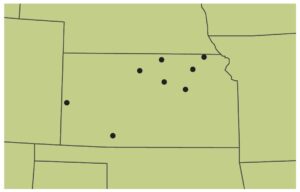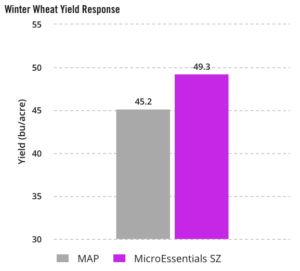OVERVIEW
- MAP (11-52-0) is commonly used as a phosphorus (P) source and applied with the seed in winter wheat cropping systems.
- In addition to nitrogen (N) and P, other nutrients like sulfur (S) and zinc (Zn) are beneficial to achieve maximum yield.
- MicroEssentials® SZ® (12-40-0-10S-1Zn) is a dry granular fertilizer that provides uniform nutrient distribution, increased nutrient uptake, and two forms of S (sulfate + elemental) for season-long availability.
TRIAL DETAILS
Crop: Wheat (Triticum Aestivum)
Years: 2017-2019
Data Source: Field studies conducted at university sites by Kansas State University.
Locations: 9 trials across 8 locations in Kansas.

Experimental Design: Small-plot RCBD with 4 replications.
Treatments: MAP (11-52-0)
MicroEssentials® SZ® (12-40-0-10S-1Zn)
N Rate: Followed local recommendations and was balanced across all treatments.
P Rate: 40 lbs P₂O₅/ac as MAP or MicroEssentials® SZ®.
S Rate: 10 lbs S/ac from MicroEssentials® SZ®.
Zn Rate: 1 lb Zn/ac from MicroEssentials® SZ®.
Application Details: Cropping systems followed local practices. Fertilizer was placed in-furrow with the seed to simulate large-scale air-drill applications.
Results

SUMMARY
- Winter wheat yields increased with the addition of sulfur and zinc.
- Averaged across 9 site-years, MicroEssentials® SZ® applied at 100 lbs product/ac outperformed MAP by +4.1 bu/ac.
- MicroEssentials® SZ® applied with the seed at planting provides superior performance to the traditional practice of only applying MAP.